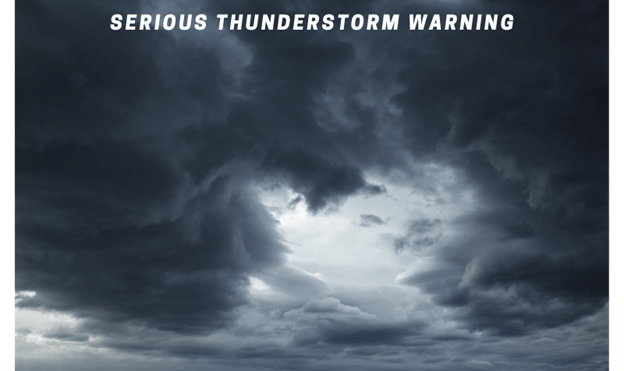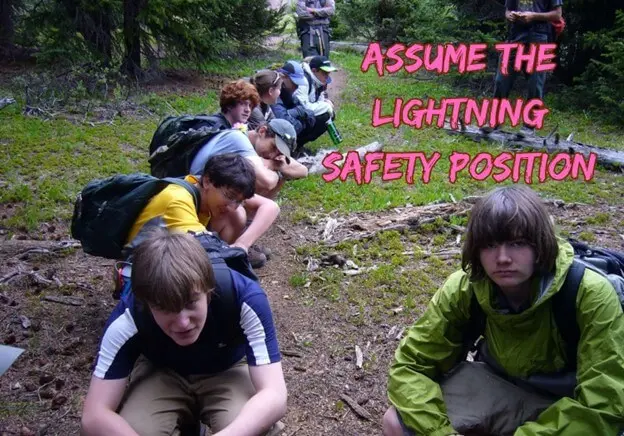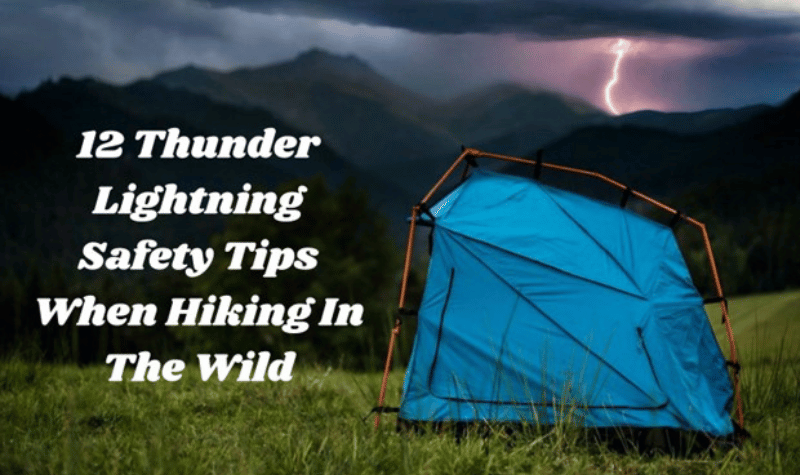Hiking in the wilderness is a thrilling flee from the rush and bustle of daily life, enabling you to immerse yourself in nature’s splendor. However, along with the stunning scenery and fresh air comes the need to be alert and well-prepared for any hazards, particularly thunder and lightning. The delight of being in the great outdoors may rapidly turn risky if you are caught unprepared in a thunderstorm.
This article offers 12 thunderstorm lightning safety tips to guarantee a safe hiking trip, enabling you to appreciate nature’s marvels while reducing hazards entirely.
Thunderstorms are atmospheric disturbances caused by warm, moist air rising and cooling, forming clouds that may expand into thunderheads. These clouds contain charged particles that collide and generate static electricity. This static electricity accumulation may result in lightning, a tremendous discharge of electrical energy between the clouds and the earth, or even inside the clouds themselves.
Hikers are at risk because they are often exposed in open settings, putting them at risk for lightning strikes. Lightning may travel through the earth, water, and even metal objects, endangering anybody in its path. A single lightning strike may transport millions of volts of electricity and produce very high temperatures, resulting in serious injuries or even death.
12 Thunderstorm Lightning Safety Tips:
1. Check The Weather Forecast Beforehand
Before going on a trek, check the weather forecast, particularly if thunderstorms are expected. Know the possibility of precipitation and monitor radar for mountain storms.
Consider delaying your trek if there is a significant risk of thunderstorms. If you decide to attend, start early since storms are most probable in the afternoon and evening.
Watch for warning signs of a coming storm, such as dark clouds, increased wind, lightning, or thunder. The closer the lightning strikes, the shorter the time before the storm comes.
Count the seconds that pass between witnessing the lightning and hearing the thunder. If the countdown is less than 30 seconds, the storm is less than 6 miles away; seek protection!
Find some low land away from solitary trees, and try not to stand out too much. Spread out so that there are at least 15 feet between each individual. Avoid bodies of water, metal things such as bags and hiking poles, and lying down.
If the hair on the back of your neck stands on edge, you should stoop as low as possible and seek shelter, avoiding water sources.
The safest place is inside a building or car, but if neither is available, search for a ravine, ditch, or cave. Avoid hiding in a tent since it provides little protection.
The storm’s immediate danger is expected to have gone after 30 minutes of no lighting or thunder. However, be careful since additional cells may be growing. Until you know the storm has passed, avoiding high, exposed areas like ridges and peaks is best. Your safety is first, so don’t be afraid to turn back if situations get unsafe.
2. Plan Hikes Early In The Day
One of the wisest things you can do is to plan your trek early in the day. Not only will you avoid the noon heat, but you will also reduce your chances of being caught in a thunderstorm.
The sun warms the earth in the afternoon and evening, causing warm, moist air to ascend quickly. So, plan to begin your trek before midday or early afternoon. You can beat the heat and storms by hitting the trails early.
It would help if you looked at the forecast for the day of your hike the night before. Check the weather forecast for the risk of thunderstorms later in the day to get an early start. The sooner you leave, the less likely you may get caught on the way.
Start your hike as soon as possible. If you’re hiking up a mountain, start climbing before the sun heats everything. Temperatures will be more bearable, and afternoon storms tend to develop over mountains.
Before you go, notify someone of your plans. Tell a friend or family member about your plans and when you expect to return.
Checking the weather, getting up early, and telling people your intentions the day before will help you and the others feel safer. A simple precaution like this might save your life in the worst-case situation. You should get an early start if you want to get the most out of your hiking trips.
3. Choose Safe Hiking Locations
Choosing a safe site and hiking path is critical to avoid risk during a thunderstorm. Here are some tips to remember:
Seek low-lying areas away from towering, solitary objects such as trees. If you hear a thunderstorm or see lightning, seek shelter in a low area and wait there for at least 30 minutes after the last sound.
Don’t let yourself become the tallest thing around. Avoid becoming the highest point nearby and an easy target by avoiding hilltops, ridges, and peaks.
Avoid metal such as motorcycles, mountain bikes, gear, bags, and hiking poles. Metal is a powerful conductor and might increase your risk of electrocution if lightning strikes nearby.
Look for shelter that is not linked to any trees. A tent, hut, or other structure that is outside of a wooded area is great. As a last option, you can sit in a ball beneath a dense growth of tiny trees or bushes, keeping twice the tree’s height away from the trunk.
When there are signs of thunderstorms in the nearby areas, it is better to avoid hiking. Your safety should always come first, so don’t be afraid to turn back if thunderstorms begin to occur. It’s better to be cautious than sorry!
4. Monitor the Sky and Cloud Patterns

Pay careful attention to the sky while hiking, and watch for changing cloud patterns. Storm clouds frequently appear as the day passes, so keep an eye on the weather even if the sky was clear when you began your journey.
Thunderstorm clouds, or cumulonimbus clouds, are towering and puffy, with flat bottoms and billowy tops. The fluffy white clouds get darker gray as they grow. These clouds suggest a thunderstorm is coming, and you should get off the way as quickly as possible. As the clouds get higher and darker, the storm’s intensity will increase.
Clouds that move quickly, particularly when they move toward you, frequently signal the arrival of a storm. The movement of the clouds will reveal the direction of the storm. To go off the path, prepare to go in the other way.
Thunder indicates that lightning is close enough to hit you. When you hear thunder, go to a safe place to wait out the storm. The storm is closer to you if lightning and thunder strike are close together.
If you see cumulonimbus clouds, hear thunder, or observe storm clouds approaching swiftly, go to a low-lying place away from alone trees immediately. To reduce your surface area, curl yourself into a ball.
If your hair stands on end, it signifies lightning is ready to hit, so squat as quickly as you can. Before returning to your walk, wait 30 minutes after the last lightning flash or thunderclap.
Following these weather and cloud pattern monitoring guidelines will help you get off the path and to a safe spot before a storm comes. Don’t gamble with lightning; cutting a trek short’s always preferable than risking your safety. Be mindful of your surroundings. The weather might differ between a fantastic hiking excursion and a potentially hazardous scenario.
5. Count The Seconds Between Thunder And Lightning

As a thunderstorm is coming closer, count the seconds between lightning and thunder. Lightning is around 1 mile distance every 5 seconds.
When lightning strikes, count the seconds till thunder. Divide seconds by 5 to determine lightning’s distance in miles.
The lightning hit roughly 6 miles distant if it was 30 seconds. At that distance, you have enough time to leave the trail. Crouch down in a low area, such as a ravine or valley. Avoid becoming the highest item in the area.
Keep an eye out for extra strikes! Keep track of the time between lightning and thunder to determine if the storm is coming or going away. If you hear thunder, it means a storm is approaching. Get to a safe spot as soon as possible.
A lightning storm may travel up to 60 miles per hour, so don’t wait. Trying to wait it out is not worth the danger. Descend as quickly as possible from exposed hills and peaks. Lightning often hits the tallest thing around; if feasible, go below the treeline or into a forest.
Avoid touching with metal things such as backpacks, hiking poles, or electrical gadgets until you’ve reached a safe zone. Before resuming, wait at least 30 minutes following the last lightning strike or thunderclap.
If you follow these tips amid a thunderstorm, you will avoid serious injury. Be proactive and aware of the proximity of lightning strikes. Don’t become a target; instead, flee to a low-lying secure spot as soon as possible. Hiking in storms is highly hazardous, so if severe weather is expected, consider finishing your hike early. Your safety comes first before any view or objective.
6. Seek Shelter Early

When a thunderstorm strikes while hiking, seeking cover as soon as possible is vital.
Seek natural shelters such as overhangs, caverns, or deep woodlands. A mature forest with lofty trees is perfect. Avoid the highest trees and keep away from the forest’s edge. It’s preferable if there’s a thick layer of trees above.
If no natural shelters are available, seek artificial structures such as picnic shelters, ranger stations, or leisure lodges. If all else fails, kneel and avoid puddles. Remove your backpack to prevent standing out as the tallest thing.
Avoid wide slopes, peak knobs, and lone trees. Squat as low as possible while maintaining safety and avoiding exposed areas. Remove any metal-framed packs.
Never lay on your back on the ground. Reduce the surface area of your body and bow as low as feasible while maintaining personal safety.
Lighting may strike up to 10 miles from the heart of a storm, so hike at least 30 minutes after the last lightning or thunder to confirm the storm has passed. It’s not worth putting your life in danger to continue on the route. Your safety is your main concern, so stay still until the threat has gone.
Keep yourself safe out there! By following these suggestions and getting appropriate protection as soon as possible, you will avoid being trapped unprepared when lightning strikes close. If storms come, cut the hike short.
7. Avoid Tall, Isolated Trees And Other Tall Objects
Staying away from tall, isolated objects should be a top concern while lightning is flashing and thunder is pounding from a distance.
Avoid the highest thing in an area, whether a tree, a clump of trees, or a rock outcrop. Descend as rapidly as possible from exposed hills and summits.
Look for low-lying regions such as valleys, depressions, or stream beds. Avoid puddles and other pools of water and crouch as low as possible.
Staying low reduces your chances of getting hit by ground current, a lethal electric shock that may flow outward following a lightning strike. The danger decreases as distance increases from the highest trees or poles.
Natural lightning rods are isolated trees, telephone poles, flagpoles, and other slim upright objects. Because lightning usually strikes the tallest thing in the vicinity, these stand-alone objects should be avoided. Remove yourself at least 35 feet from any solitary tall item.
Squat down in a lower place in a forest because trees are more likely to be hit. Stay careful and avoid being the tallest object and if your hair stands on end, dive to the ground quickly. It is important to seek cover or drive away as quickly as possible until 30 minutes after the last lightning strike or thunderstorm is heard( I know, I said it before…but it is very important).
Following these precautions during strong thunderstorms might save your life. Drop from exposed regions as quickly as possible, avoid isolated towering objects, keep low to the ground, and seek cover as soon as feasible. It’s better to be safe than sorry, so don’t keep trekking if lightning is close!
8. Avoid open fields and mountain peaks
When hiking in the wilderness during a thunderstorm, it’s crucial to understand the principles of lightning behavior and how they relate to terrain. Lightning tends to follow the path of least resistance, which typically means it will strike the highest object in a given area. This is why you should avoid open fields and mountain peaks during a thunderstorm, as these locations increase your risk of being struck by lightning.
Here’s a more detailed explanation:
- Open Fields: Open fields provide little to no protection from lightning. If you’re hiking in an area with vast open spaces, such as a meadow or grassland, you become the tallest object in the vicinity. Lightning is more likely to strike you or the ground nearby, posing a significant risk.
- Mountain Peaks and Ridges: Mountain peaks and ridges are among the highest points in the landscape, making them extremely vulnerable to lightning strikes. When you’re on a peak or ridge during a thunderstorm, you are essentially an elevated lightning rod, greatly increasing your chances of being struck. The rocky terrain can also conduct electricity.
9. Assume the Lightning Safety Position

Your hair standing on end during a storm is a warning that lightning is nearby. To prevent getting electrified, immediately take the lightning safety stance.
Tuck your chin in, and don’t be tall, so you’re not the easiest target you can be.
Crouch on the balls of your feet to reduce contact with the earth. Cover your ears with your hands to shield them from the loud sound of a prospective attack. Avoid laying down flat since the huge electrical charge increases your heart or lung damage risk.
With the proper safety procedures, you may enjoy hiking even on days with potential thunderstorms.
10. Distance Between Hikers
Maintaining a safe space between yourself and other hikers is crucial, particularly if thunderstorms are expected.
If lightning hits close to your group, the electrical charge may move between nearby metal items such as ice axes, trekking poles, and rucksack metal pieces. The greater the distance between you, the less likely everyone in the group will be impacted. Keep at least 30 feet (10 meters) apart from other hikers as a general guideline.
Allow enough room in all directions for one another. Do not gather, even for a little rest or food. Instead, spread out along the route. If lightning hits the tallest item, like a tree, in the area, your group will be less of a target.
Remove your backpack and any trekking poles or other metal things you may be carrying. Place them away from you until 30 minutes after the last lightning strike or thunderclap. Your safety is more crucial than any piece of equipment.
Staying spaced out, avoiding exposed places, dropping metal equipment, and kneeling can dramatically lower your chance of lightning injury during a thunderstorm. It may be inconvenient, but your safety and the safety of your fellow hikers should come first. Always remember to head inside when thunder claps! The same is true for hiking: get to a safe location as soon as feasible.
11. Wait Until After the Storm Passes

The storm should be heading away from you until you hear the final rumbling of thunder. Don’t keep hiking, lightning may strike up to 10 miles from a thunderstorm. Before returning to the trail, seek cover and wait at least 30 mins after the last lightning strike or thunderclap.
In this case, it’s better to be cautious than sorry. Staying for an additional half-hour will not put you behind schedule and is worth your safety.
After 30 minutes of no thunder or lightning, the storm should have moved 10-15 miles away, reducing the risk of a hit to your position. Before proceeding, double-check the sky for any evidence of residual storm clouds in case the system halted or changed course.
Hikers and outdoor lovers should always be aware of the weather and know how to react to lightning. While most summer storms pass in an hour, be prepared to cut your trek short for safety if one creeps in and stays. Your life is more important than reaching the top or finishing the whole path.
It is preferable to be safe and damp than to be seriously hurt by the deadly strength of an electrical storm. So, use cover if lightning threatens, wait 30 minutes after the storm’s final symptoms, and move below the treeline if exposed at a high height. The mountains will remain for you to climb another day. Your life only ends once.
12. Learn Basic First Aid
Learning basic first aid while hiking may help save lives in emergencies. Here are some important tips to remember:
Learn how to diagnose injuries and do CPR. In an emergency, contact emergency services right away. Make the wounded individual as comfortable as possible while waiting for aid. Learn how to heal wounds, splint broken bones, and treat medical problems like hypothermia.
Have a first aid kit with you at all times. Bandages, gauze, antiseptic, pain relief, antihistamine for allergic responses, medical tape, scissors, and any necessary over the counter or prescription medications should all be included. You never know when these items may come to the rescue.
Understand how to handle minor injuries. Cuts, abrasions, and puncture wounds should be cleaned and bandaged. Sprains, strains, and swellings should be treated with ice or cold compresses. Apply moleskin or bandages to blisters. Learn how to ease the discomfort caused by bug bites and stings.
Prepare yourself for severe weather. Learn how to recognize and treat heat and cold-related disorders such as heat stroke, heat exhaustion, hypothermia, and frostbite. Severe weather may create potentially hazardous conditions, so plan your trek properly.
Learn the fundamentals of navigation and communication. If you become lost, know how to read a map and use a compass. Carry emergency supplies such as pocket knives, waterproof matches or lighters, emergency coverings, and a whistle to summon help.
Staying safe in the woods takes alertness and preparation. Knowing first aid and prepping for emergencies might help you avoid tragedy. Concentrate on prevention and know how to react efficiently in crisis circumstances. You’ll enjoy your hiking experience if you take the necessary measures.
Additional Resources
If you are looking for more tutorials, walkthroughs and troubleshooting about camping and enjoying the outdoors, here are some additional posts to check out:
Conclusion
This concludes our discussion of 12 tips to remember the next time you’re out enjoying the outdoors and the weather turns for the worse. Following these tips will help you get home safely from thunder and lightning, particularly in the wilderness.
Stay calm and watchful, go to a low place away from towering, isolated things, and try not to be the tallest object nearby. Avoid puddles and other pools of water and try crouching as low as possible.
And if your hair stands on end, that signifies lightning is approaching, so drop everything and get down instantly. Let’s safely explore the outdoors with respect and awareness of Mother Nature’s power. Thanks for reading, If you think I forgot something or if you simply want to share a story or some advice, Please leave your comment below. Be safe and Have fun!


Thank you for the article. You may want to check your data on a storm moving 60 miles per minute! Thats a bit fast!
Thank you my friend, a little typo mistake…lol….